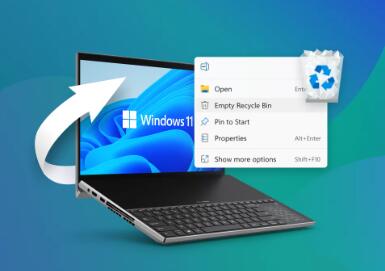Accidentally deleting important files on your PC can feel like a nightmare. Whether it’s a work project, school assignment, treasured photo, or video collection, the panic that sets in is universal. But here’s the good news: in most cases, deleted files can be recovered even if you emptied the Recycle Bin or used permanent delete commands.
1. How File Deletion Works on a PC
When you delete a file, it usually doesn’t disappear immediately. Instead:
Windows: The file is moved to the Recycle Bin, unless you use Shift + Delete or delete from removable media (which bypasses the bin).
Mac: The file is moved to the Trash, unless you use Option + Command + Delete or have “Remove items from the Trash after 30 days” enabled.

When the bin or trash is emptied, the file’s reference in the file system is removed, and the storage space is marked as available. But the actual data remains on the drive until overwritten by new data — which is why recovery is possible.
2. Immediate Actions After Deleting a File
If you want the best chance at recovery:
Stop using the affected drive immediately (avoid creating or saving new files).
Do not install recovery tools on the same drive where the files were deleted.
Begin the recovery process quickly — the sooner you act, the better the results.
3. Restoring Files from the Recycle Bin (Windows)
If you deleted the file recently and haven’t emptied the Recycle Bin:
Open the Recycle Bin by double-clicking its desktop icon.
Locate your file (use the search bar if needed).
Right-click → Restore — it returns to its original folder.
Tip: If the Recycle Bin is missing from your desktop, right-click the desktop → Personalize → Themes → Desktop icon settings → check Recycle Bin.
4. Restoring Files from the Trash (Mac)
If you’re on a Mac:
Click the Trash icon in the Dock.
Locate your file.
Right-click and select Put Back to restore it to its original location.
5. Retrieving Files After Emptying the Recycle Bin or Trash
This is where things get tricky. Once the bin or trash is emptied, the OS no longer knows where the file is stored — but the raw data may still exist.
You can recover it using:
Built-in OS recovery tools
Cloud backups
Specialized data recovery software like Panda Assistant
6. Using Windows Built-in Recovery Tools
6.1 File History
If enabled:
Type “File History” into the Start menu.
Select Restore your files with File History.
Browse for the deleted file and click the green Restore button.
6.2 Backup and Restore (Windows 7)
Open Control Panel → Backup and Restore (Windows 7).
Select Restore my files.
Follow the prompts.
7. Using Mac Built-in Recovery Tools
7.1 Time Machine
If enabled:
Connect your Time Machine backup drive.
Open the folder where the deleted file was located.
Click the Time Machine icon → Enter Time Machine.
Select the file from a previous backup and click Restore.
8. Using Cloud Storage Recovery
If your files were stored in or synced with a cloud service, check its restore options:
OneDrive: Right-click the file in the online portal → Restore.
Google Drive: Check the Trash folder → Restore.
Dropbox: Use Deleted files section to recover older versions.
iCloud Drive: Log in to iCloud.com → Data Recovery.
9. Using Panda Assistant for Professional Recovery
If backups don’t exist, Panda Assistant is one of the most effective tools for retrieving deleted files on a PC — even after the bin is emptied.
For Windows PCs:
Download Panda Assistant (to a drive other than the one with deleted files).
Launch it and select the affected drive.
Choose Deep Scan for maximum recovery.
Preview results to confirm files are intact.
Save recovered files to another location.
For Mac PCs:
Install Panda Assistant on an external drive.
Select your Mac’s main drive.
Run a full scan.
Preview and recover files to a different device.
Why Panda Assistant stands out:
Supports multiple file systems (NTFS, FAT32. APFS, HFS+)
Recovers photos, documents, videos, and more
User-friendly with high recovery success rates
10. Special Cases: USB Drives and External Hard Drives
Deleted files from USBs and external drives bypass the Recycle Bin entirely. Recovery requires tools like Panda Assistant or PhotoRec.
11. Recovering Files from SSDs
If your PC uses an SSD, recovery chances may be lower due to the TRIM feature, which can permanently erase deleted data. Still, act fast and try Panda Assistant immediately.
12. Prevention Tips for the Future
Enable File History or Time Machine.
Use cloud sync for critical files.
Avoid permanent delete shortcuts unless necessary.
Regularly back up to an external drive.
13. Frequently Asked Questions
Q1: Can I recover permanently deleted files for free?
Yes, some tools offer limited free recovery, but full recovery usually requires a paid plan.
Q2: How long are files recoverable after deletion?
Until they’re overwritten by new data. There’s no set time limit.
Q3: Is recovery guaranteed?
No — it depends on how much the drive has been used since deletion.
Retrieving deleted files on a PC is often possible — especially if you act fast. Start by checking the Recycle Bin or Trash, then move on to backups or cloud services. If those fail, a powerful recovery tool like Panda Assistant can help you restore files quickly and effectively.
About us and this blog
Panda Assistant is built on the latest data recovery algorithms, ensuring that no file is too damaged, too lost, or too corrupted to be recovered.
Request a free quote
We believe that data recovery shouldn’t be a daunting task. That’s why we’ve designed Panda Assistant to be as easy to use as it is powerful. With a few clicks, you can initiate a scan, preview recoverable files, and restore your data all within a matter of minutes.

 Try lt Free
Try lt Free Recovery success rate of up to
Recovery success rate of up to









